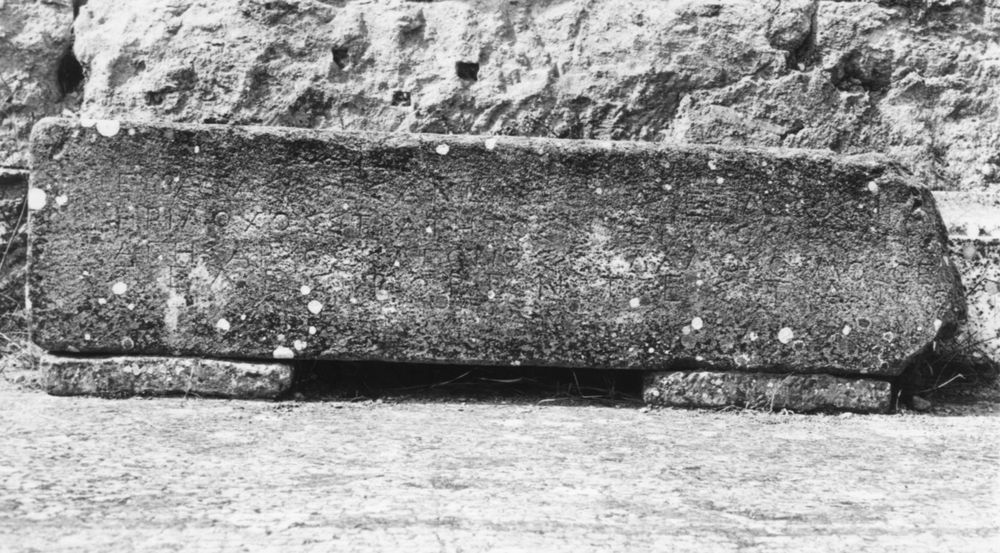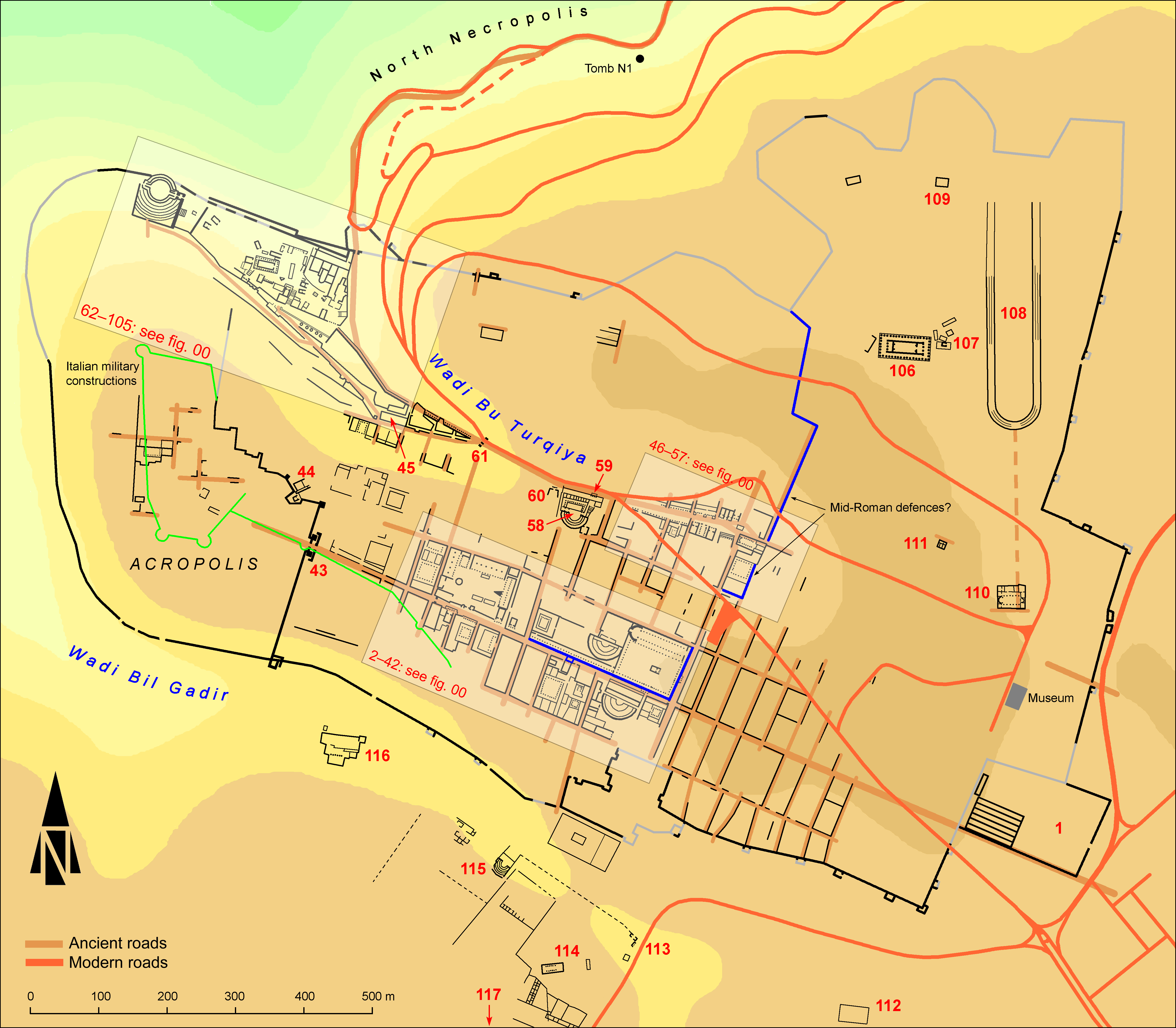EpiDoc XML:
IGCyr0994002
Trismegistos ID:
738512
Source description
Support: White marble block broken off at right, with three large dowel holes on top, probably linked to a later use (w: 1.29 × h: 0.30 × d: 0.74).
Layout: Inscribed on front face in probably three columns of three lines each, followed by a single line on the whole width; a supplementary letter was scratched by a second hand at line 1 of column a.
Letters: Lines 1 to 3 0.026, line 4 0.03; beta with rather large loops, slanting mu and sigma, phi with large loop, open upsilon.
Date: Ca. 365 BC (prosopography, lettering).
Findspot: Found by R.M. Smith and E.A. Porcher in 1861 at Cyrene ➚: in the so-called Hall of the Orthostats.
Place of origin: Cyrene ➚: possibly from one of the temples in the quarter of the Agora (see commentary)
Last recorded location: Seen in 1960 by Pugliese Carratelli at Shahat: in the Hall of the Orthostats. Seen by C. Dobias-Lalou in 2010 at the same place. Seen by E. Rosamilia in 2012 at the same place.
Text constituted from: Transcription from stone (CDL).
Bibliography
Smith – Porcher 1864, n. 18, whence SGDI 4837 and DGE 232; Oliverio 1929, p. 130, footnote 3; Oliverio XVI.9, whence SECir, 146 and figg. 107-108s; IGCyr 099400 ➚; Rosamilia 2023, p. 84-85 (findspot), pp. 196-197 (typology), pp. 372-373, number 99 (text). Cf. Laronde 1987, p. 114, whence SEG, 38.1891; Adams 2003, p. 57 and Dobias-Lalou, BE, 2005.623, whence SEG, 53.2044; Dobias-Lalou 2020, p. 245-248.
Text
Apparatus
1: Ἀκεσάνδρω SECir a second nu was inserted by another hand after the main one: Τελέσαν{ν}δρω Smith – Porcher 1864, SGDI, DGE
5: Ἀρισ[τ---]: Ἀρισ̣[τ---] SECir; Ἀριστ[---] Smith – Porcher 1864, SGDI, DGE
10: τὰν ὀ[πὰν ἀνέθηκαν] Oliverio 1929: τὰν ὀ[πὰν](vac.) SECir Pugliese finding Oliverio's restoration too long; τὰν ο̣[---] DGE; τὰν Ο[---] SGDI; τὰν θ[όλον?] SGDI Hiller von Gaertringen; τὰν θ[υσίαν?] SGDI Hiller von Gaertringen; τὰν θ[εάν] Smith – Porcher 1864
French translation
Eubatas fils d'Akésandros, Erilokhos fils de Stratès, Hagesarchos fils de Kléôn
Aleximakhos fils d'Aiglanôr, Etymoklès fils d'Arist[---], Damokosmos fils de The[---
Untel fils d'Untel, Untel fils d'Untel, Untel fils d'Untel
ont consacré] cette baie lors de la telesphoria.
English translation
Eubatas son of Akesandros, Erilochos son of Strates, Hagesarchos son of Kleon
Aleximachos son of Aiglanor, Etymokles son of Arist[---], Damokosmos son of The[---
So-and-so son of So-and-so, So-and-so son of So-and-so, So-and-so son of So-and-so
dedicated] this bay while celebrating the telesphoria.
Italian translation
Eubatas figlio di Akesandros, Erilochos figlio di Strates, Hagesarchos figlio di Kleon,
Aleximachos figlio di Aiglanor, Etymokles figlio di Arist[---], Damokosmos figlio di The[---
il tale figlio del tale, il tale figlio del tale, il tale figlio del tale
hanno dedicato] questo vano in occasione della telesphoria.
Commentary
Pugliese Carratelli at SECir, 146 republished the inscription with photograph and sketch from Oliverio's papers (his notebook number XVI dates of 1936).
With the most plausible restoration, this stone is explicitly the architrave overlooking a door (ὀπά). Its findspot corresponds to a re-use, but the idea expressed at IGCyr, that it might belong to the temple which is thought to have antedated the Hall of the Orthostats should probably be dropped. The width of the stone, if completed as proposed, would be about 2.5. The shorter restoration proposed by some scholars at l. 10 would lead to ca. 1.7, which would be too short for a third column of names and too long for only two columns.
Rosamilia 2023 discusses the various temples without pronaos in the vicinity which would match such an architrave. His best hypotheses are 1) Apollo's temple on the agora, 2) the temple of the Dioscuri in the Eastern part of that area, 3) and less probably the anonymous and levelled off temple E3 on the agora.
The restoration of Aiglanor as father's name at line 4 is certain, as no shorter form of this typically Cyrenaican name is attested at Cyrene. This allows to have a basis for restoring the overall dimensions of the stone.
Both Pugliese Carratelli at SECir, 146 and Adams 2003 mention holes on the upper face to accommodate a statue. But the shape of the holes does not correspond to feet. If they were intended for attachment of some object, this would be for to a later use, perhaps in the Hall of the Orthostats, where the stone presently lies.
Some letters echoing those of the inscription were probably scratched on the front face by visitors (see at l. 1); however we found no hint of those drawn by Oliverio below the inscription in his sketch given at SECir, fig. 108. Rosamilia 2023 suspects that Pugliese Carratelli did not understand on Oliverio's drawing a sketch of the sequence with a sperfluous N in the second name of line 1, appended by Oliverio below the image of the inscription.
CC BY-NC-SA 4.0 Deed Attribution-NonCommercial-ShareAlike 4.0 International License.
All citation, reuse or distribution of this work must contain a link back to DOI: https://doi.org/10.60760/unibo/igcyrgvcyr2 and the filename (IGCyr000000 or GVCyr000), as well as the year of consultation.


